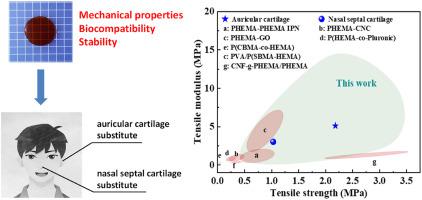Polymer ( IF 4.6 ) Pub Date : 2022-06-18 , DOI: 10.1016/j.polymer.2022.125083 Yi Wang , Hongyan Ouyang , Yuanjie Xie , Yinan Jiang , Lijuan Zhao , Wanliu Peng , Junliang Wu , Ji Bao , Yong Liu , Jinrong Wu

|
Poly(2-hydroxyethyl methacrylate) (PHEMA) hydrogel is highly biocompatible and stable, but its actual application in soft-tissue replacement is limited by its poor mechanical properties. This study develops a facile strategy to construct PHEMA-based hydrogels with the highest strength and toughness ever reported. The strategy relies on introducing robust coordination interactions between the carboxylate groups of copolymerized maleic acid (MA) units and Fe3+ to suppress the phase separation of PHEMA chains from aqueous solution, thereby inducing a homogeneous network. The homogeneous network can avoid stress concentrations, and dynamic coordination crosslinking can effectively dissipate energy and simultaneously maintain network elasticity. The synergistic effects of these two factors impart exceptionally high tensile strength (3.44 MPa), elastic modulus (14.22 MPa), and toughness (4.17 MJ/m3) to the hydrogels, which are 22.7, 43.1, and 24.2 times higher than those of pure PHEMA hydrogels, respectively. Such mechanical properties are comparable to human nasal and auricular cartilage. The hydrogels manifest outstanding self-recovery properties and fatigue resistance, which are essential for long-term and sustainable use. In vitro cell and in vivo animal experiments show that this strategy does not sacrifice the excellent biocompatibility and stability of the PHEMA hydrogels. These PHEMA-based hydrogels, with excellent mechanical properties, fatigue resistance, and biocompatibility, are promising candidates for replacing diseased or damaged nasal and auricular cartilage.
中文翻译:

强分子间相互作用和抑制相分离的协同作用使基于 PHEMA 的水凝胶具有机械强度、生物相容性和耐用性
聚(2-甲基丙烯酸羟乙酯)(PHEMA)水凝胶具有高度的生物相容性和稳定性,但其在软组织置换中的实际应用受到其较差的机械性能的限制。这项研究开发了一种简便的策略来构建具有最高强度和韧性的基于 PHEMA 的水凝胶。该策略依赖于在共聚马来酸 (MA) 单元的羧酸酯基团和 Fe 3+之间引入稳健的配位相互作用抑制 PHEMA 链与水溶液的相分离,从而诱导均匀的网络。均质网络可以避免应力集中,动态配位交联可以有效耗散能量,同时保持网络弹性。这两个因素的协同作用使水凝胶具有非常高的拉伸强度(3.44 MPa)、弹性模量(14.22 MPa)和韧性(4.17 MJ/m 3),分别是水凝胶的 22.7、43.1 和 24.2 倍。分别为纯 PHEMA 水凝胶。这种机械性能可与人类鼻和耳软骨相媲美。水凝胶表现出出色的自我恢复性能和抗疲劳性,这对于长期和可持续使用至关重要。体外细胞和体内动物实验表明,这种策略不会牺牲 PHEMA 水凝胶优异的生物相容性和稳定性。这些基于 PHEMA 的水凝胶具有优异的机械性能、抗疲劳性和生物相容性,是替代患病或受损的鼻和耳软骨的有希望的候选者。


























 京公网安备 11010802027423号
京公网安备 11010802027423号